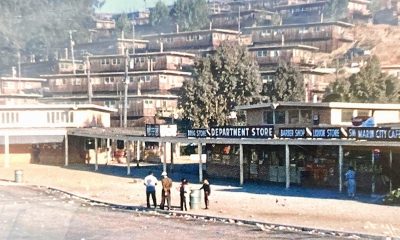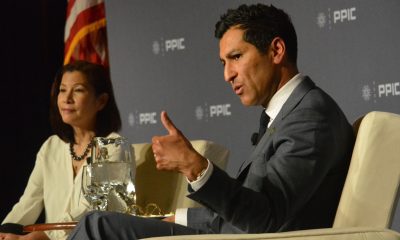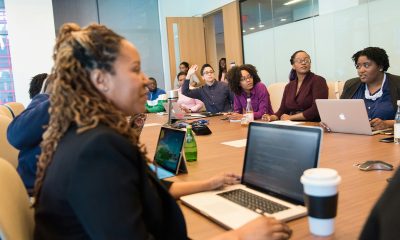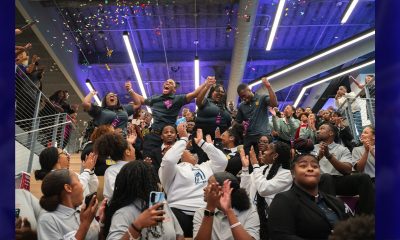Education
Local Marin City Students Receive $61,000 in Scholarships
The Sausalito Woman’s Club presented a record $61,000 in educational scholarships 40 high school graduates and college students from Sausalito and Marin City on Sunday, June 1.
< p>Twenty-three of the forty students were from Marin City.
The scholarships were awarded at a special ceremony and reception held at the Woman’s Club.
Sausalito Woman’s Club Scholarship Recognition Fund (SWCSRF) Chair Jean Patterson congratulated the students, praising them for their accomplishments.
Dr. Elizabeth Talley of Marin City, a pediatric nephrologist at Oakland’s Children’s Hospital and a clinical instructor at Stanford University’s School of Medicine, was the guest speaker. While a student, she received scholarships and support from the from the scholarship fund through college and medical school.
Talley spoke of her own journey to reach her dream and encouraged the students not to give up, that when one door shuts another will open.
Chautiana Thomas, a local singing talent, sang “A Hero Lies in You” at the event.
The scholarship program is supported solely by community fundraising and individual donations as well as commemorative and memorial gifts. This year, eight scholarships, named for individuals and organizations were awarded to the following students:
The Michael B Heyman Memorial Scholarship was awarded to Gian-Paul Bergeron, Sarah Leider and Silvana Meira.
The Sausalito Presbyterian Church Scholarship was awarded to Janay Garrard.
The Sausalito Woman’s Club Memorial Scholarship was awarded to Malachia Hoover.
The Nancy Debruyn/Shannon Bell Memorial Scholarship was awarded to Ramona Polk.
The Phil Frank Memorial Scholarship was awarded to Jason Rasmussen.
The Elaine B. Squires Memorial Scholarship was awarded to Jasmine Roary.
The SWC Scholarship Recognition Fund provides financial support, encouragement and acknowledgement to deserving students seeking higher education. The fund has awarded more than $820,000 in scholarships since its founding in 1956.
Recipients of the scholarships must be residents of either Sausalito or Marin City and planning to attend an accredited college, graduate school or vocational or arts institution.
For information, go to http://sausalitowomansclub.org/scholarship
Art
Marin County: A Snapshot of California’s Black History Is on Display
The Marin County Office of Education, located at 1111 Las Gallinas Ave in San Rafael, will host the extraordinary exhibit, “The Legacy of Marin City: A California Black History Story (1942-1960),” from Feb. 1 to May 31, 2024. The interactive, historical, and immersive exhibit featuring memorabilia from Black shipyard workers who migrated from the South to the West Coast to work at the Marinship shipyard will provide an enriching experience for students and school staff. Community organizations will also be invited to tour the exhibit.

By Post Staff
The Marin County Office of Education, located at 1111 Las Gallinas Ave in San Rafael, will host the extraordinary exhibit, “The Legacy of Marin City: A California Black History Story (1942-1960),” from Feb. 1 to May 31, 2024.
The interactive, historical, and immersive exhibit featuring memorabilia from Black shipyard workers who migrated from the South to the West Coast to work at the Marinship shipyard will provide an enriching experience for students and school staff. Community organizations will also be invited to tour the exhibit.
All will have the opportunity to visit and be guided by its curator Felecia Gaston.
The exhibit will include photographs, articles and artifacts about the Black experience in Marin City from 1942 to 1960 from the Felecia Gaston Collection, the Anne T. Kent California Room Collection, The Ruth Marion and Pirkle Jones Collection, The Bancroft Library, and the Daniel Ruark Collection.
It also features contemporary original artwork by Chuck D of the Rock and Roll Hall of Fame group Public Enemy, clay sculptures by San Francisco-based artist Kaytea Petro, and art pieces made by Marin City youth in collaboration with Lynn Sondag, Associate Professor of Art at Dominican University of California.
The exhibit explores how Marin City residents endured housing inequities over the years and captures the history of plans to remove Black residents from the area after World War II. Throughout, it embodies the spirit of survival and endurance that emboldened the people who made Marin City home.
Felecia Gaston is the author of the commemorative book, ‘A Brand New Start…This is Home: The Story of World War II Marinship and the Legacy of Marin City.’ Thanks to the generous contribution of benefactors, a set of Felecia’s book will be placed in every public elementary, middle, and high school library in Marin.
In addition, educators and librarians at each school will have the opportunity to engage with Felecia in a review of best practices for utilizing the valuable primary sources within the book.
“Our goal is to provide students with the opportunity to learn from these significant and historical contributions to Marin County, California, and the United States,” said John Carroll, Marin County Superintendent of Schools.
“By engaging with Felecia’s book and then visiting the exhibit, students will be able to further connect their knowledge and gain a deeper understanding of this significant historical period,” Carroll continued.
Felecia Gaston adds, “The Marin County Office of Education’s decision to bring the Marin City Historical Traveling Exhibit and publication, ‘A Brand New Start…This is Home’ to young students is intentional and plays a substantial role in the educational world. It is imperative that our community knows the contributions of Marin City Black residents to Marin County. Our youth are best placed to lead this transformation.”
The Marin County Office of Education will host an Open House Reception of the exhibit’s debut on Feb. 1 from 4 p.m. – 6 p.m.. All school staff, educators, librarians, and community members are encouraged to attend to preview the exhibit and connect with Felecia Gaston. To contact Gaston, email MarinCityLegacy@marinschools.org
Community
The Year Ahead: Assembly Speaker Rivas Discusses Priorities, Problems
Assembly Speaker Robert Rivas shared his legislative priorities and vision for the future of California during a luncheon hosted by the Public Policy Institute of California (PPIC) in downtown Sacramento.
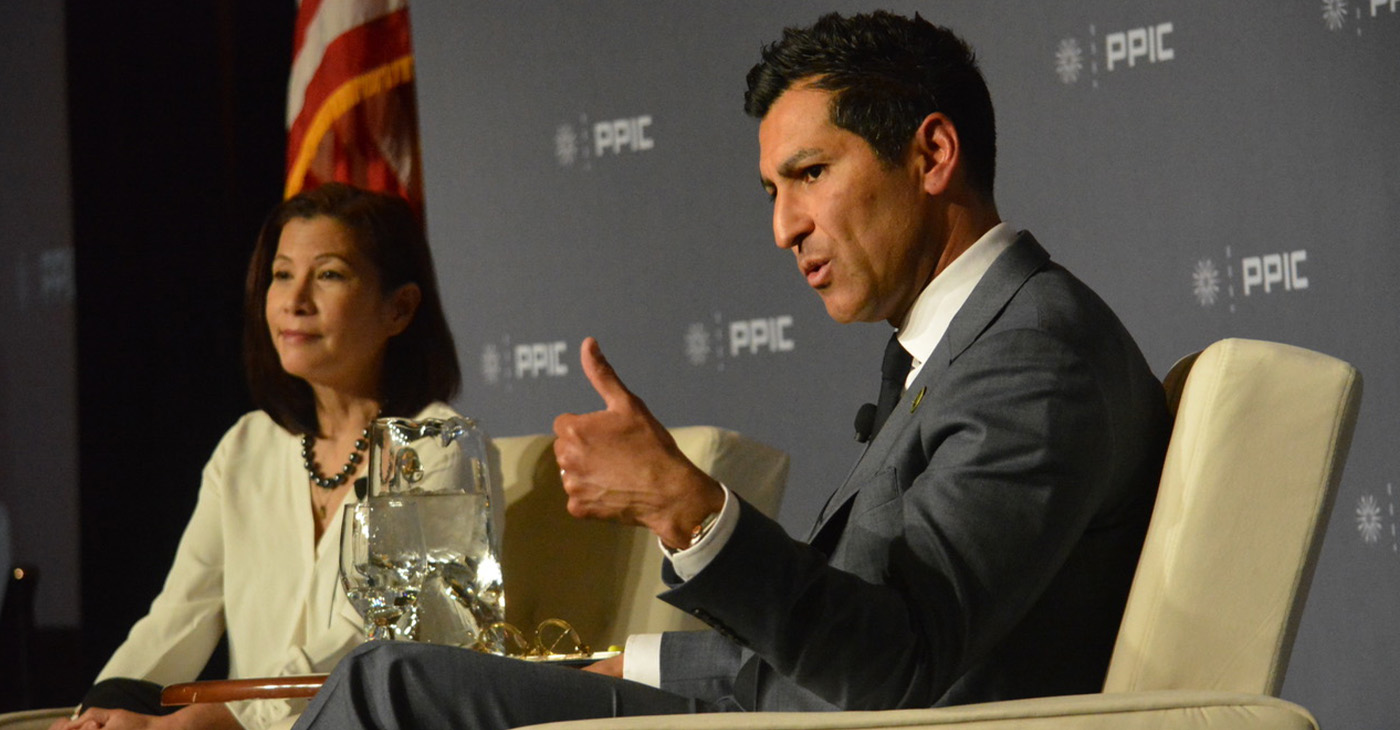
By Antonio Ray Harvey, California Black Media
Assembly Speaker Robert Rivas shared his legislative priorities and vision for the future of California during a luncheon hosted by the Public Policy Institute of California (PPIC) in downtown Sacramento.
Titled a “Conversation with Assembly Speaker Robert Rivas” for PPIC’s 2024 Speaker Series on California’s Future, the 44-year-old Democrat lawmaker from Hollister, who represents the 29th Assembly District, is the 71st speaker of the Assembly.
The discussion at the Sheraton Hotel took place about two weeks after Gov. Gavin Newsom presented his $291 Billion January budget proposal.
“These are going to be difficult times,” Rivas said of the task of balancing a budget that has been estimated separately by the Department of Finance and Legislative Analyst’s Office to have a deficit between $38 billion and $68 billion. “It’s going to underpin everything we get done this year. It’s going to impact everything.”
PPIC’s Speaker Series on California’s Future allows “leaders, lawmakers, and changemakers with diverse perspectives to participate critically, constructively, and collaboratively in public conversations,” according to PPIC.
PPIC president and Chief Executive Officer Tani Cantil-Sakauye was the moderator of the 60-minute discussion that about 200 guests attended.
Rivas said right after he was sworn in as the Assembly leader that among his top priorities are mental and medical wellness, public safety, affordable housing, homelessness, education, the state’s entry-level scientists’ wages, and climate change.
He added that his goal is to focus on both urban and rural areas across the state, including improving public services and infrastructure. He explained that wildfires, flooding, droughts, and agriculture productivity are additional concerns.
Rivas shared that legislators should have goals of “addressing critical issues” that lead to “progress, affordability, and improving day-to-day” quality of life for all residents in California.
“These issues are consistent across the state. I prioritize no region over the other,” Rivas told Cantil-Sakauye, the former chief justice of the California Supreme Court.
During the question-and-answer portion of the conversation, Michael L. Younger, the Vice President of Workforce, Strategy, and Innovation at Calbright College asked Rivas about how the state can help individuals with workforce training and achieve labor success without relying on traditional colleges and university.
“(I am) speaking to those who may not see themselves on the college track but also have value to society,” Younger asked Rivas.
In his response, Rivas said the labor force needs individuals with work training skills, especially with the rise and usage of artificial intelligence.
“The need to have that transition can’t come soon enough but at the same time we have a responsibility to train displaced workers,” Rivas said.
Carmen-Nicole Cox, director of Government Affairs for American Civil Liberties Union – California Action, asked the Speaker would he accept the “community’s invitation” to take a public health approach to addressing public safety rather than one that criminalizes, demoralizes and focuses on incarceration.
Rivas responded to Cox’s question by explaining that an impartial evaluation of public safety should be made initially before providing a resolution.
“Our approach to addressing public safety is to, first, listen, to be fair throughout our process and to find solutions. Does that include addressing public health? Absolutely,” he said.
Community
Report: Black Enrollment at Calif. Colleges and Universities Remains Low and Flat
A report the non-partisan Legislative Analyst’s Office (LAO) released last week revealed that Black student enrollment at California’s institutions of higher learning has remained relatively low and flat. Over the last two decades, for example, the study found that, compared to all other ethnic groups, total Black student enrollment at the University of California (UC) has increased by a miniscule one percentage point.

By California Black Media
A report the non-partisan Legislative Analyst’s Office (LAO) released last week revealed that Black student enrollment at California’s institutions of higher learning has remained relatively low and flat.
Over the last two decades, for example, the study found that, compared to all other ethnic groups, total Black student enrollment at the University of California (UC) has increased by a miniscule one percentage point.
During that period, Black young adults from 18 to 24 years old accounted for between 7% and 8% of the state’s total population but the number enrolled at UC remained in a disproportionately low range, between 4% and 5%.
White student enrollment at UC decreased the most over that time period from 42% in 2000 to 23% in 2021.
Latino student enrollment at UC increased from 14% to 31% and Asian American and Pacific Islander (AAPI) student enrollment remained relatively constant from 39% to 40%. But the AAPI total percentage of AAPI students attending UC remained at almost two times higher than the state’s total population of college-aged AAPI students, which moved from 13% to 15% over that period.
Titled “Student Access,” the report focuses on pathways and barriers to enrollment in higher ed, examines admissions policy, categorizes enrollment by academic specialization, and provides demographic information on students attending California’s private universities and public university systems: California Community Colleges (CCC), California State University (CSU) and the University of California (UC).
“The series has two main objectives,” the report’s introduction reads.
“The first is to help legislators, staff, and the general public track many of the key changes that higher education has undergone over the past few decades,” it continues. “The second is to help legislators and staff leverage their better understanding of the past to aid them in better navigating the future.”
According to the LAO, the report highlights priorities it recommends members of the Legislature to consider in their decision-making around the budget or higher education policy.
-

 Activism4 weeks ago
Activism4 weeks agoOakland Post: Week of March 20 – 26, 2024
-

 #NNPA BlackPress3 weeks ago
#NNPA BlackPress3 weeks agoMayor, City Council President React to May 31 Closing of Birmingham-Southern College
-

 #NNPA BlackPress3 weeks ago
#NNPA BlackPress3 weeks agoCOMMENTARY: D.C. Crime Bill Fails to Address Root Causes of Violence and Incarceration
-

 #NNPA BlackPress3 weeks ago
#NNPA BlackPress3 weeks agoFrom Raids to Revelations: The Dark Turn in Sean ‘Diddy’ Combs’ Saga
-

 #NNPA BlackPress3 weeks ago
#NNPA BlackPress3 weeks agoCOMMENTARY: Lady Day and The Lights!
-

 #NNPA BlackPress3 weeks ago
#NNPA BlackPress3 weeks agoBaltimore Key Bridge Catastrophe: A City’s Heartbreak and a Nation’s Alarm
-

 #NNPA BlackPress3 weeks ago
#NNPA BlackPress3 weeks agoBaltimore’s Key Bridge Struck by Ship, Collapses into Water
-

 Activism3 weeks ago
Activism3 weeks agoOakland Post: Week of March 27 – April 2, 2024

